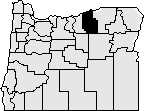
Morrow County was created in 1885 from the western portion of Umatilla County and a small portion of eastern Wasco County. It was named after Jackson Lee Morrow, an early settler in the area and member of the Legislative Assembly when the county was created.
Morrow County is located in the north central part of the state and east of the Cascade Mountains. The county is bounded by the Columbia River on the north, Umatilla County on the east, Grant County on the south, and Gilliam County on the west. The county contains 2,049 square miles.
Heppner was designated the temporary county seat at the time the county was created and narrowly defeated Lexington in the election held in 1886 to determine the permanent county seat. Heppner was originally called Standsbury Flat for George W. Standsbury, one of the first white settlers in the area. The settlement's name was changed to Heppner in 1873, in honor of Henry Heppner who in partnership with Jackson Morrow established a store in the town.
The first courthouse was a frame structure completed shortly after Heppner was confirmed as the county seat. In 1902, the wooden courthouse was torn down and replaced the following year by the present courthouse, which is constructed of native bluestone with sandstone trim.
Morrow County government includes a county judge, two county commissioners, district attorney, assessor, clerk, sheriff, surveyor, justice of the peace, and treasurer. The Morrow Port District, situated on the Columbia River near the town of Boardman, was established in 1958.
Early cattlemen found an abundance of rye grass along the creek bottoms of the region and drove their herds into the area to forage. They established cattle camps and from them grew the county's first settlements. Stock raising was the primary economic force in the county for many years. Increased settlement, the enclosure of the free grazing lands and diminished pastures due to overgrazing, resulted in the decline of ranching during the 1900s. Farming and other agricultural pursuits became predominant. The completion of rail lines into the county in 1883 increased access to markets and encouraged wheat production in the area. The principal industries in the county today include agriculture, food processing, utilities, lumber, livestock, and recreation.
Heppner was almost destroyed by a flood on June 14, 1903. The flood was precipitated by a sudden cloudburst and accompanying hail that caused a dam collapse and flash flooding. A wall of water and debris swept down the creeks and canyons and through the town. It has been estimated that 247 people were drowned. Property damage was reported at nearly $1,000,000. The nearby towns of Ione and Lexington also sustained significant damage.
Morrow County experienced steady growth in population reaching a peak in 1920 with 5,617 people. The county's population declined in the following years and did not surpass the 5,000 mark again until 1978. More recently, the north part of the county along the Columbia River has experienced more rapid growth with development of dairy, product distribution, tree farms, and other activities. The 2011 population of 11,270 represented an increase of 0.9% over 2010.